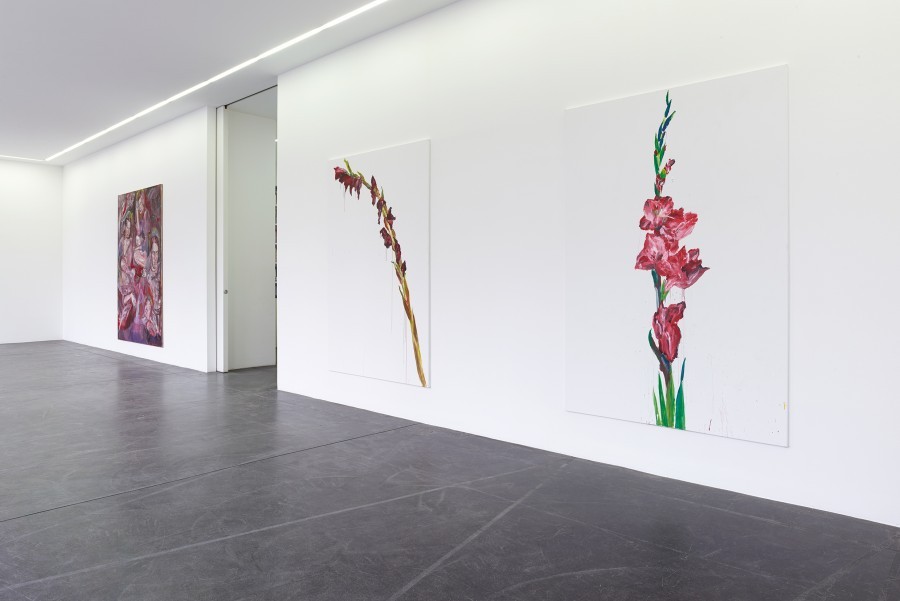Hans-Jörg Mayer
Nora von Waldstätten
20 Jan - 10 Mar 2018

Hans Jörg Mayer
“Nora von Waldstätten”
Installation view
Galerie Nagel Draxler, Berlin
Photo: Simon Vogel
“Nora von Waldstätten”
Installation view
Galerie Nagel Draxler, Berlin
Photo: Simon Vogel
HANS-JÖRG MAYER
Nora von Waldstätten
20 January – 10 March 2018
Hans-Jörg Mayer’s flower paintings are made in repetition of a movement that is impossible to end. Again and again he takes new flowers, that are decaying from picture to picture. In principal it is a rapid mode of painting on pre-primed canvas off the roll.The measurements of the pieces, that Mayer fixes on the studio-wall with a tacker gun, match the span of his arm holding the brush. Translated into this physically determined size, the motifs emerge on the canvas: Concentrated, intense, painted. From object to eye to movement to picture, this vaguely describes the frequency, that is seemingly executed without any judgement. Large parts of the canvas remain white, what becomes even more conspicuous as the splashes and drippings produced by the painting process are emphasising the presence of this white, by staining it. The pencil strokes, with which Mayer marks the corners of the canvases, are also visible in some places. They belong to the paintings, simply because they are there. Thus, for sure, Mayer’s work here doesn’t resemble the exercises Asian monks would practice, and in which artist and tool merge in perfection to make the ego disappear. To the contrary, the titles of Mayers paintings, Whip, Jiz Lee, Peaches, are brimming with desire.
In Dreamers from 2003 Mayer refers to the visual codes of advertisements in glossy magazines. One can hardly escape the crossing and parting gazes of the figures portrayed in the painting. There are strong semantic elements and perhaps the question, what painting as art is capable of. If the painter with this work is referring to an outside, then with the flower paintings he is referring to himself. The question here is not, what painting as art is capable of, but maybe, what is at the center here, is the always strongly denied question, what a single being is capable of: What am I capable of? The painter is always alone. The fully unsublime aesthetic procedure of aloneness is not every painter’s thing. It is risky, direct and takes place beyond the ruling discourses.
Nora von Waldstätten
20 January – 10 March 2018
Hans-Jörg Mayer’s flower paintings are made in repetition of a movement that is impossible to end. Again and again he takes new flowers, that are decaying from picture to picture. In principal it is a rapid mode of painting on pre-primed canvas off the roll.The measurements of the pieces, that Mayer fixes on the studio-wall with a tacker gun, match the span of his arm holding the brush. Translated into this physically determined size, the motifs emerge on the canvas: Concentrated, intense, painted. From object to eye to movement to picture, this vaguely describes the frequency, that is seemingly executed without any judgement. Large parts of the canvas remain white, what becomes even more conspicuous as the splashes and drippings produced by the painting process are emphasising the presence of this white, by staining it. The pencil strokes, with which Mayer marks the corners of the canvases, are also visible in some places. They belong to the paintings, simply because they are there. Thus, for sure, Mayer’s work here doesn’t resemble the exercises Asian monks would practice, and in which artist and tool merge in perfection to make the ego disappear. To the contrary, the titles of Mayers paintings, Whip, Jiz Lee, Peaches, are brimming with desire.
In Dreamers from 2003 Mayer refers to the visual codes of advertisements in glossy magazines. One can hardly escape the crossing and parting gazes of the figures portrayed in the painting. There are strong semantic elements and perhaps the question, what painting as art is capable of. If the painter with this work is referring to an outside, then with the flower paintings he is referring to himself. The question here is not, what painting as art is capable of, but maybe, what is at the center here, is the always strongly denied question, what a single being is capable of: What am I capable of? The painter is always alone. The fully unsublime aesthetic procedure of aloneness is not every painter’s thing. It is risky, direct and takes place beyond the ruling discourses.
